Garden Journal: Solstice Update From the Laughing Dragon Garden
Since we just made it to the Summer Solstice, I realized that we are way overdue for a garden update from the Laughing Dragon garden.
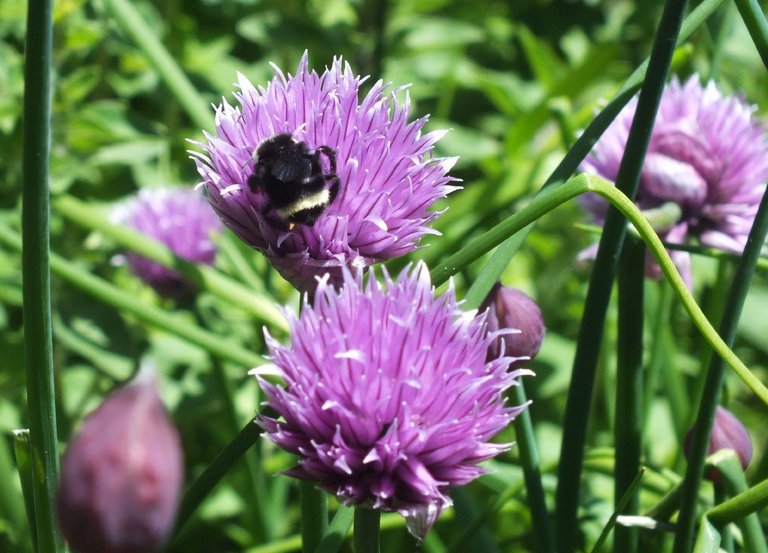
A bumblebee enjoying our chives!
Seems like summer is finally on the horizon, even though what we locally refer to as the "June Gloom" (fog) often greets us in the morning and sometimes hangs around till late afternoon. Today, we even woke up to a steady rain. But that's just part of the joy of gardening in a coastal climate!
We got a rather late start this year, for reasons that will be fully explained in a future post(s)... reasons that — at least for a while — made us wonder whether we'd even have a garden this year.
But that's a whole separate story, as I said.
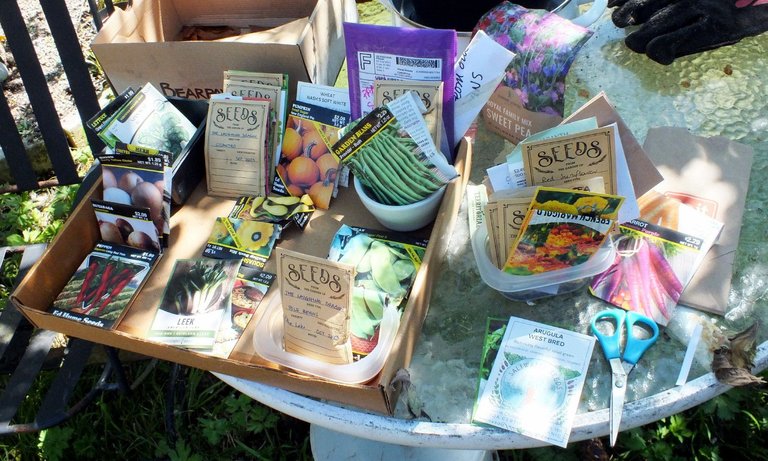
Getting out and sorting the seed box. Many of the seeds are our own self-collected heirloom seeds.
As things turned out, we really weren't able to do much till early May, and not just for weather reasons.
Keeping a garden is an unpredictable affair, and there's never any telling what's going to do well and what's going to be a miserable flop! Seems we're getting our share of both, this year.
One of our earliest spring surprises — and quite a treat, to boot — was that a bunch of red beets had made it through winter and could be harvested.

Winter bounty!
That made for a large batch of pickled beets, which make for a lovely condiment for a variety of dishes and sandwiches.
I use an old Danish recipe; slightly sweet, and with the addition of cinnamon and fresh horseradish to add some spice.

On the whole, the herb bed did well over the winter.
Our oregano/marjoram is a pretty hardy and even aggressive strain that seems to take root and thrive, even in spots where nothing else will grow.

A veritable forest of oregano
The chives were a positive surprise as the handful of puny plants we left in the fall suddenly sprang to life and grew into a veritable forest, with lots of beautiful purple blooms that attracted lots of bees... good for the whole garden.
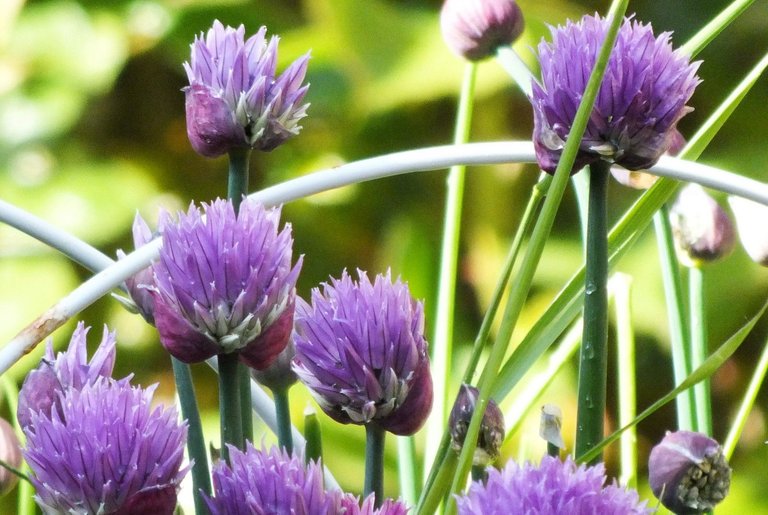
Chives in bloom...
My solitary tarragon plant also made it through winter with flying colors! That was another upside surprise, as I have always found tarragon to be rather delicate and finicky.
The thyme was looking a bit wilted and tired so it got a stiff haircut, after which it decided to spring back to life and now looks very healthy.
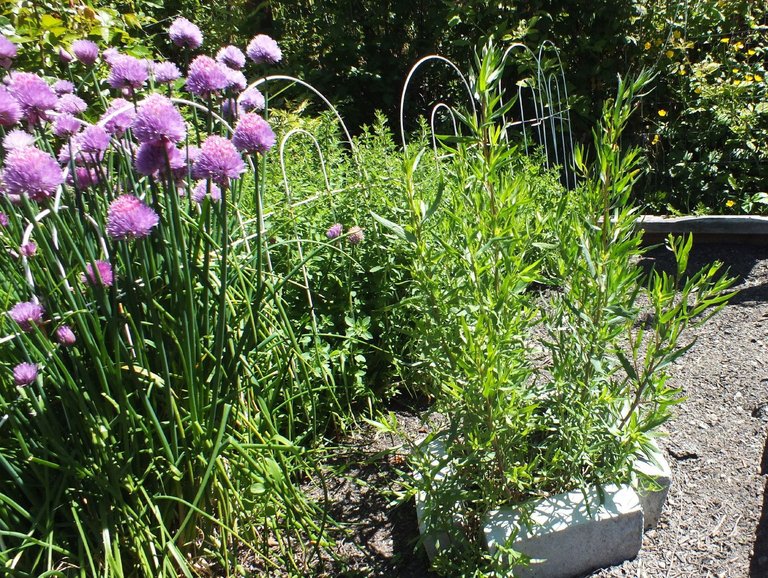
Thriving herbs: Chives (left), Oregano (back, center), Tarragon (between bricks)
The only other thing that seemed to have wintered well — and didn't get drowned by the swampy conditions — was the strawberries. They were setting record number of flowers already in early April, and we were, in fact, able to pick the first berry on June 1st. As I write these words, we can harvest a large bowl full of fresh berries every morning for our breakfast/brunch, and they are some of the best berries ever!

Freshly picked, yum!
Our apple trees put on a spectacular show of flowers this spring, and from the looks of things, I think we're going to end up with a bumper crop of apples by mid-August and into September. I think I'll try my hand at making apple cider, this year!
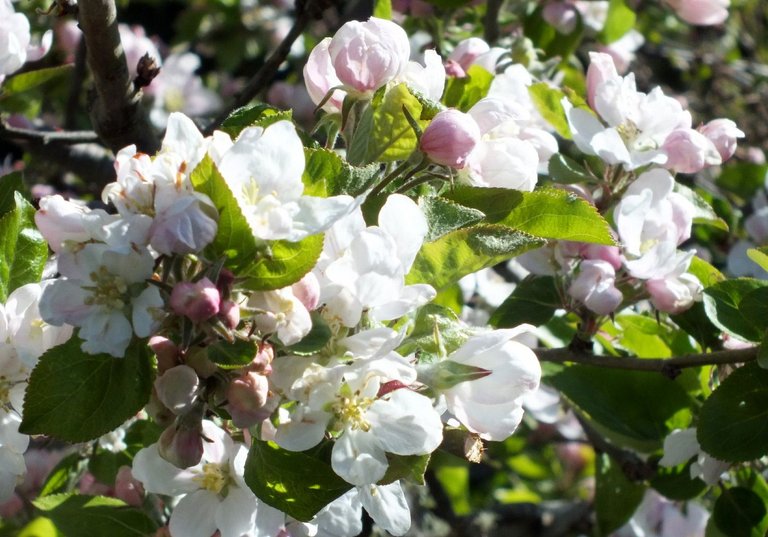
Apple blossoms, back in April
Soil Testing and Similar Science!
Last fall, a number of our plants were quite disappointing and puny — in spite of having added some allegedly premium soil — so this spring we invested in a soil testing kit, so we could see whether perhaps we had been doing something wrong.
Well, it turned out that several of our raised bed were essentially dead and devoid of any kind of nutrients. Checking back with the soil provider, we discovered that their pride in their soil having "no weed seeds" was tied to the fact that the soil was essentially lifeless and sterile!

The apples are forming. Come late August, it should be a great crop!
Which helped explain how a pile of soil could sit in the driveway for nine months and not a single solitary weed ever tried to take root in it!
So, you live and you learn! "Clean" soil doesn't necessarily mean fertile soil for growing anything.
Thus, some heavy-duty fertilization had to happen, and a lot of the new plantings for this spring look a lot healthier than last year's bunch.
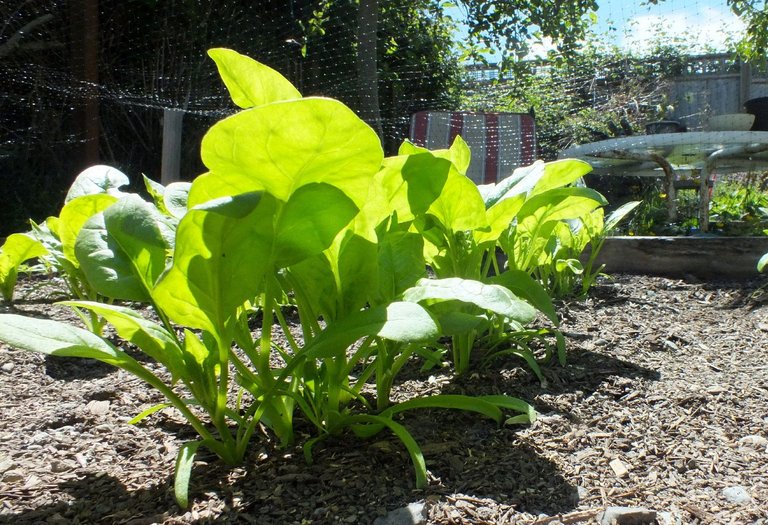
Bug's eye view of baby spinach!
With the beets removed, we decided to use that particular raised bed for a mixture of leeks and spinach. The spinach showed up quickly and almost immediately started bolting (because it got too warm) and the leeks are getting a slow start... a reminder that sometimes leeks are two year plants.
With the first set of spinach already picked and out of here, we decided to re-use the bed for lettuce and arugula... it's so nice to be able to pick fresh greens for sandwiches and meals, well into the fall!

Despite the cool grey weather, the tomato plants are setting blooms!
Pests, Pests, Pests...
As mentioned up top, every year is different.
This year we seem to have battled pests and varmints and other setbacks more than I can remember us ever having had to. We have voles, and rats, and mice, and even moles galore... and even the birds have taken a liking to picking tiny seedlings, so everything has had to be covered.
We really knew we had a battle on our hands when first we had "something" come in and essentially shave an entire bed of arugula and lettuce seedlings to the ground, leaving barely any signs of green behind.
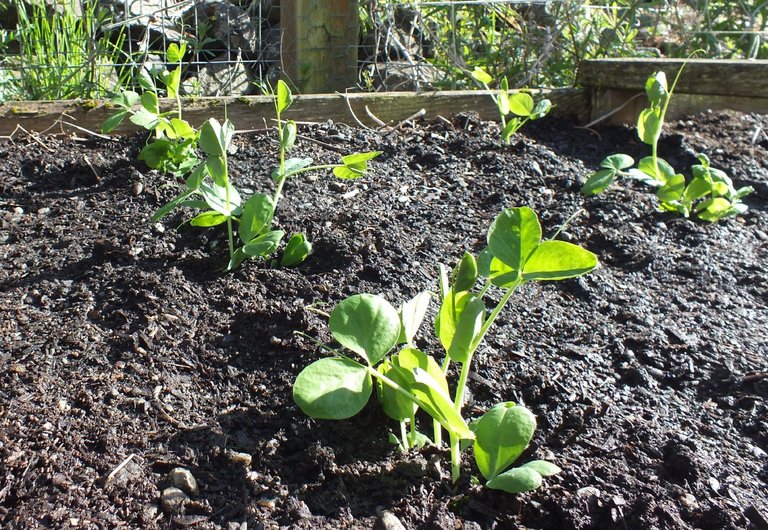
Our snow pea seedlings... before they got cut down by voles... or rats
A few days later the same "something" decided that the snow peas — which I had painstakingly grown in pots — were a great delicacy and decided to basically chop off just the fresh top shoots on every plant!
So we had to actually construct a cage made from hardware cloth to put over them... and even so, the little bandits still dug their way in, but ended their days in one of our traps. Not fond of killing these little creatures, but there are so many of them this year... and this is our food, as well!

Lots more strawberries still to come!
Of course, we've also had to do pretty constant battle with the usual population of the Pacific Northwest's most prolific garden pest: Slugs. I hate it when I turn over a perfect strawberry, only to discover that the other side has been munched by slugs!
Fruits and Berries
While the strawberries are definitely being very successful this year, we're still waiting on other crops.
@denmarkguy painstakingly nurtured some black raspberry shoots that grew largely as "volunteers," and they seem to be doing quite well, although we are preparing for battle with the birds, for the harvest.

The black raspberries are still a couple of weeks out, maybe three.
I have two small blueberry bushes that always try their best, and do produce some lovely berries... but that's also a battle against the birds; we'll be using plenty of bird netting, this year!
Surprisingly, the blackberries — otherwise the single most invasive plants we have — are not looking healthy this year. In fact, a whole patch of them look more or less dead. Strangely enough, those plants are in the same corner of the garden that's been trickling so much water into the soil... so you do sort of have to wonder if there's some sort of toxicity to that runoff. After all, there are septic systems uphill from us... although poop is usually pretty good fertilizer!
That said, other things — like bleach, chemicals and vinegar — also end up in septic systems.
Well, it's probably best that I stop with this update for now, before it gets ridiculously long! Hopefully I'll find the time to update more regularly, as summer progresses.


Thank you for reading, please share your thoughts because I love comments and then take a minute to look at the community of Silverbloggers and join us if you think you qualify. (If you think you qualify, you probably do!)
With soil so devoid of life, and an unbalanced soil, pests will have a field day with the weaken plants. They will seek them out over healthy plants as they can digest them better.
But it looks like many things did ok for you. I hate the slugs too!
We're trying to bring it all into balances again. In talking with a few neighbors who keep gardens, pests seems to have been a particular problem this year. I suspect there has been a dying out of some key predator; we've seen no weasels or stoats this year at all, and they are usually plentiful. Our local flocks of coyotes are also conspicuous by their absence.
Wow, that's really amazing, red beetroot, this is the first time I've seen that fruit, and the strawberries look really lush, I really like them ,Hope you get satisfactory results, friend.❤️🙏
Beets are not something many people are familiar with; they are quite popular in Scandinavia and northern Europe.
Your garden plants looks good, strawberries from garden are treat - even with little or no care strawberries in our garden give lovely fruits
Voles and slugs are usual suspects - duck can take care of some slugs
Interesting part about your blackberries, like you said they are so resilient
Voles can eat their roots. Regarding septic systems too much water may not be most ideal for plants, maybe roots froze during cold times or roots rot due to too much water
You may try add some drainage in that corner of your garden
All best with your garden and your plants
We used to keep chickens and they took care of a lot of our insect pests, but the neighborhood association decided to prohibit the keeping of chickens. Quite annoying. Yes, ducks are very good at controlling slugs.
We have redirected the water that flooded the garden... there will be more about that whole nightmare in a future post!
I see. Duck are useful and they dont do damage to garden plants as chicken can. If chicken find good looking strawberries, zucchini, cucumber or tomato they will help themselves and try them
Have a nice day
Wow, I really loved this update — it felt like walking through the Laughing Dragon Garden right alongside you, fog, rain, slugs, and all! 😊
I could almost taste those cinnamon-spiced pickled beets and smell the oregano in the air. It’s inspiring to see how much care and observation you put into everything, even when pests and poor soil try to steal the show. 😇 I’m looking forward to hearing the “late start” story and seeing how your apple cider experiment turns out. And the blueberries! I hope you install enough net to protect them against the birds.
The septic system, I guess, is the suspect for the blackberries' condition. Human waste, especially if untreated, is not a good fertilizer; it could contaminate crops with harmful pathogens. I hope the blackberries recover. 💚
Your reply is upvoted by @topcomment; a manual curation service that rewards meaningful and engaging comments.
More Info - Support us! - Reports - Discord Channel
Thank you!
Working on putting together the whole "late start" and "clearing the swamp" story this week, and hopefully will have it out within a couple of days! It was quite a project.
The thing about septic systems is that so much more than just human waste goes in there: grease from cooking, detergent from washers and dishwashers, bleack from toilet cleaners and such. It can be a very toxic soup, even if the water looks clear and clean.
Good luck with your project! I hope to see progress in the coming days. And it's really the septic system that's affecting the poor plant. May you find the best solution to save the plants. 💜💚
Loved the pics and great words also, friend.
Thank you for visiting!
Wow various kinds of fruit in your garden.Best of luck👌🤝
Thank you, appreciate your kind wishes.
Nice picture of the bee & chives.🌱🐝
Thank you!